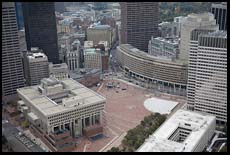
Aerial Photography
by Philip Greenspun; revised August 2018
Site Home : Photography : Aerial Photography

by Philip Greenspun; revised August 2018
Site Home : Photography : Aerial Photography
Aerial photography is an important commercial skill. Real estate is a big portion of our economy and usually the best way to illustrate the value of a building or piece of land is with a photograph taken from a helicopter or airplane.
Aerial photography is an important artistic skill. A lot of the world's most interesting patterns are only apparent from the air.
There is only one thing that aerial photography seldom works for: conveying the experience of being up in the air. When you're sitting up front in a light plane or helicopter, you look up at a panoramic view of open sky. You look forward and sideways at a 180-degree stretch of horizon. You look down and see interesting features on the ground all around you. An aerial photograph that isolates a shopping mall is a useful thing for shopping mall developers, but it doesn't remind a pilot of flying over that shopping mall.
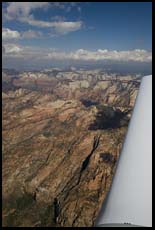
Airplanes are easy to borrow from friends or rent from local flight schools, but you're almost always working around a strut or a wing. The old photojournalists say "If your pictures aren't good enough, you're not close enough"; the FAA says that airplanes can't fly lower than 1000' above congested areas or 500' from any person, structure, or vessel. Airplanes cannot be flown slowly. A typical four-seat airplane is unsafe to operate below about 80 mph.
What are the best airplanes for photographic missions? Traditionally, high-wing Cessnas are favored for their slow speeds and wide windows that open. The Cessna 177RG Cardinal is probably the best of this species, because it lacks a wing strut and the landing gear retracts out of the way. [You can buy a nice one for $80,000.]
With a helicopter, you can fly with your door removed. You now have almost complete freedom to use your camera as you would in any other situation. A helicopter can legally be flown at any altitude, as long as there is an open area of some sort to which the helicopter could autorotate in the event of engine failure and not create a hazard to persons or property on the surface. In practice, this means that helicopters may be flown very low indeed. The most efficient speed for a helicopter is usually around 60 mph and, if necessary, the machine may be slowed down to a mid-air hover or even flown backwards over the ground.
Modern helicopters are extremely reliable and you are very unlikely to crash due to a mechanical failure. The fatal accident rate in light helicopters is about 1 in every 100,000 flight hours, with most accidents being related to bad weather or a pilot attempting a challenging maneuver, such as landing in his friend's backyard and not noticing the trees or powerlines.
If you are flying solely for the purpose of taking pictures, it is unlikely that you would depart into hazardous weather; the kinds of weather that make flying dangerous are generally those that make photography impossible. You're taking off and landing at an airport, a huge open area. What are the main risks then? Helicopters are subject to a phenomenon known as "settling with power." If a helicopter is brought to a mid-air hover and then slowly descends, it will eventually come into contact with its own disturbed air. Sinking into sinking air results in an alarmingly rapid descent rate. We do this all of the time in training students, and they always manage to get out of it by pushing forward to increase the helicopter's speed, but we start 3000' above the ground, not 300'. Ask your pilot to circle the spot that you want to photograph, not to park the helicopter in mid-air. If you must ask for a mid-air hover, make sure that you are pointing into the wind. If the pilot is a fresh-faced flight instructor, don't ask for anything too fancy. Contrary to what you'd expect, it is typically the youngest and least experienced pilots who are teaching the raw beginners.
Helicopter pilots sit on the right seat of the aircraft. You will probably sit on the left side. Anything that comes out of your pocket will tend to blow back into the tail rotor. The best that you can hope for in this situation is an expensive dent in the tail rotor. The worst is tail rotor failure, which an alert and proficient pilot can handle by entering an autorotation, but really it is better to remember to take everything out of your pockets and put them under the seat. Do not get in or out of the helicopter while the blades are spinning. People tend to walk back into the tail rotor, which spins so fast that is hard to see. If you must get out, crouch a bit and keep eye contact with the pilot. If you can see the pilot, you can't be back with the tail rotor.
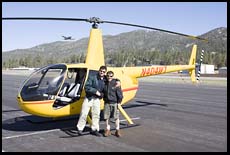
Most major cities have "helicopter charter" companies who will be happy to take you up in their $1000/hour jet-powered helicopters. If that doesn't suit your budget, look for a "helicopter flight school". Typically these will operate piston-engine Robinson R22 and R44 helicopters. The two-seat R22 is the most economical, at typical prices of $225-275 per hour, including the pilot. The quarters are extremely cramped in the R22; you'll be elbowing the pilot if you lean back a little bit to keep a telephoto lens out of the slipstream. The R22 also cannot be operated legally with more than about 400 lbs. of pilot, passenger, and luggage. If you're not compact and slender, it is probably best to fly in an R44, which is more stable and has the added convenience of a back seat in which to place an assistant or equipment that you're not using. The R44 typically rents for $450-700 per hour with pilot.
Contrary to theories put forward by some scientists, the Earth is actually quite flat. Aerial photos taken under midday conditions when the sun is high look very flat indeed. It is best to fly in the first or last hour of the day, when the sun's angle will produce shadows that enable viewers to understand the shapes of the hills and structures in a photo.
As the aircraft circles the subject, you will be capturing an exposure every second or two. From every 10 to 50 images captured, you'll be selecting one to present or display. This is a great time to use a digital camera with the largest memory card you can afford. Fill up the memory card and sort through the results on the ground.
Another advantage of digital is the preview capability. People aren't usually at their sharpest in the unfamiliar environment of an aircraft. If you're going to make a mistake in your photographic life, this is the most likely time and place. The ability to verify that your images are reasonably well exposed and focussed is very welcome.
If you're using a professional-style digital camera, set the file format to "RAW" so that you can fine-tune the exposure on your home computer. When up in the air, concentrate on getting the framing and focus right.
The sharpest pictures are taken with the camera on a tripod, using the self-timer or a cable release to ensure that the touch of the photographer's fingers don't jostle the camera. How, then, is it possible to get a sharp photo from a rapidly moving aircraft that is simultaneously being vibrated by the engine?
The factors that influence motion-blur are the following:
The easiest and best way to freeze motion is by using a fast shutter speed. Somewhere between 1/500th or 1/750th of a second freezes most blur with lenses up to 100mm in length on a full-frame camera. On a digital SLR, set the exposure mode to "S" for "shutter priority" or "Tv" for "time-value priority". Use the main control dial to select "500", "640", or "750" and the camera's internal meter will determine a corresponding lens aperture for correct exposure given the lighting. On nearly every compact digital camera, you can do the same thing but it requires wading down into the menus. (An explanation of aperture, shutter speed, and exposure may be found in the Exposure chapter of Making Photographs.)
If it is a sunny day, you're probably in great shape now, with an
aperture of f/5.6 and pictures coming out looking good in the preview
window. What if the camera's aperture display is flashing "f/2.8" and
the preview pictures are too dark? It is probably late in the
afternoon on a cloudy day and the lens won't open up wide enough to
admit sufficient light at the short shutter speed. You can increase
the camera's sensitivity to light by adjusting the ISO, which
typically defaults to 100, up to 400 or 800. Most point and shoot
cameras don't perform well at high ISO, one reason why people buy
digital SLRs. The bigger the sensor, the better the performance in
low light, which is what makes
One advantage of using a helicopter is that you seldom need a lens longer than 100mm to isolate a landmark. If you're flying high in an airplane and taking pictures of ordinary-sized buildings, you'll need to use telephoto lenses of 200mm and longer, which will require higher shutter speeds to freeze camera shake.
If your camera or lens has an image stabilizer, by all means turn it on. When that isn't sufficient, as it never will be for video, the standard solution is to mount the camera on a handheld gyro stabilizer. Kenyon Laboratories builds, rents, and sells these items, which resist any kind of motion. The lunch is not quite free, however, as the Kenyon gyro is heavy and while it is fighting the helicopter's attitude deviations in turbulence, your arms will be fighting with the gyro/camera combination. Spend a few months in the gym before planning to use one of these for longer than 15 minutes.
Don't brace yourself against the aircraft; you'll only pick up vibration. Try to sit quietly and not touch your arms or the camera against any part of the helicopter or airplane.
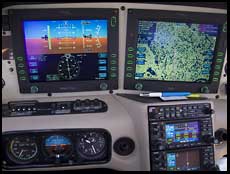
Use the focal length calculator in the Lens chapter of Making Photographs before getting into the aircraft. Plan on being 1000' above the subject in an airplane or 300' in a helicopter. If the project is to photograph a house on a quarter-acre lot (100' square) with a small-sensor digital SLR, for example, the required lens is 225mm from an airplane or 70mm from a helicopter.
In attempting to capture the experience of flying, true wide-angle focal lengths between 16 and 28mm (full frame) are the most useful. The wide lens will inevitably include parts of the aircraft in the image, but that was part of your experience. When including the interior of the aircraft, e.g., the pilot or a passenger, experiment with using an on-camera flash to balance the comparatively dim light inside the airplane with the bright scene outside.
When you've got all day to take the perfect photo, you get the best quality with a bag of prime (non-zoom) lenses, moving the tripod a few feet every 10 minutes to try out different perspectives. When the jet-powered helicopter is sucking down fuel at the rate of $1000/hour, it is better to sacrifice a little bit of quality for the convenience of a zoom lens. As an added bonus, many of today's better quality zoom lenses include built-in image stabilizers.
Good aerial photography starter outfits include the following:
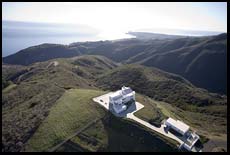 |
Showing this mansion in Malibu and the surrounding rugged terrain required zooming out to 21mm
( |
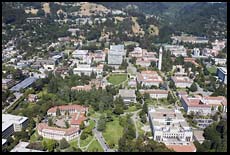 |
Boring mid-day light and a boring 35mm focal length (slightly wide) makes for a boring photo of University of California, Berkeley.
( |
 |
Downtown Chicago. Same boring mid-day light and 35mm focal length, but a more interesting subject and angle.
( |
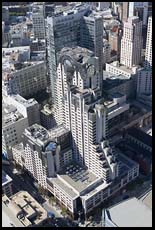 |
If you owned the building, you might enjoy this photo, taken at a 50mm (normal) focal length.
( |
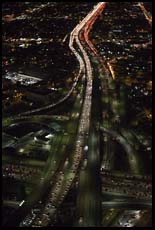
|
It tends to be dark at night, a situation that calls for a
|
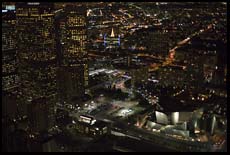
|
As the angle gets progressively steeper, the photo gets progressively less conventional...
Helicopters can be easily banked to 60 degrees and more. There is no risk of stalling the wing. Ask your pilot to make a "steep turn" and just lean over slightly to point the camera nearly straight down.
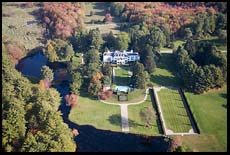
One of the best reasons to take up aerial photography as a hobby is that it is the only way to see those portions of the United States that are fenced-off or at the end of private drives.
Henry David Thoreau saw our modern confinement coming in his June 1862 Atlantic magazine essay, Walking:
... most of my townsmen would fain walk sometimes, as I do, but they cannot. No wealth can buy the requisite leisure, freedom, and independence which are the capital in this profession. ... I know very well that they have confined themselves to the highway ever since ... the walking of which I speak has nothing in it akin to taking exercise, ... but is itself the enterprise and adventure of the day. ...
Moreover, you must walk like a camel, which is said to be the only beast which ruminates when walking. When a traveler asked Wordsworth's servant to show him her master's study, she answered, "Here is his library, but his study is out of doors." ...
When we walk, we naturally go to the fields and woods: what would become of us, if we walked only in a garden or a mall? ...
There are square miles in my vicinity which have no inhabitant. From many a hill I can see civilization and the abodes of man afar. The farmers and their works are scarcely more obvious than woodchucks and their burrows. Man and his affairs, church and state and school, trade and commerce, and manufactures and agriculture even politics, the most alarming of them all--I am pleased to see how little space they occupy in the landscape...
At present, in this vicinity, the best part of the land is not private property; the landscape is not owned, and the walker enjoys comparative freedom. But possibly the day will come when it will be partitioned off into so-called pleasure-grounds, in which a few will take a narrow and exclusive pleasure only--when fences shall be multiplied, and man-traps and other engines invented to confine men to the public road, and walking over the surface of God's earth shall be construed to mean trespassing on some gentleman's grounds. To enjoy a thing exclusively is commonly to exclude yourself from the true enjoyment of it. Let us improve our opportunities, then, before the evil days come.
Are Thoreau's "evil days" here? For the ground-bound, certainly, but it is possible to fly almost anywhere in the United States one wishes for the simple pleasures of looking and photographing.
The author was the founder and Editor in Chief of photo.net. He holds an Airline Transport Pilot certificate from the FAA. He is a flight instructor for both airplanes and helicopters at East Coast Aero Club and has flown multiple Robinson helicopters from the factory in Los Angeles to Massachusetts and Florida.
Text and pictures copyright 2005-2018 Philip Greenspun